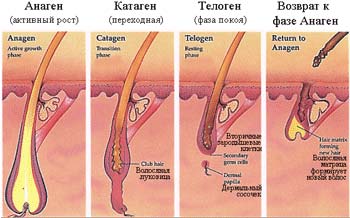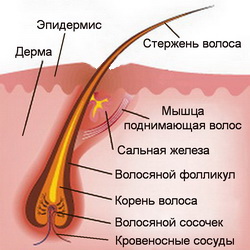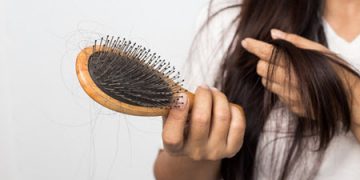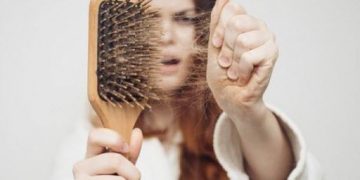How to deal with diffuse hair loss? Symptoms, Causes and Treatment
Over the years of hair loss treatment, I realized the most important thing: first of all, you need to determine the type of alopecia (hair loss) and find out causes of hair loss, which is even more difficult. There are several types of alopecia: anrogenic, diffuse, focal, nested, cicatricial. Let us dwell in more detail on diffuse hair loss - this is the most common type of alopecia among women.
The main distinguishing feature of diffuse hair loss from other types of alopecia is that hair falls out evenly over the entire head. The hair itself remains completely healthy, but at the same time it falls out, and its natural recovery is slowed down. Diffuse alopecia is a consequence of a general imbalance in the body. To put everything on the shelves, let's start with the life cycle of the hair. Each hair goes through its own life cycle - three phases of anagen, catagen, telogen.
The anagen phase is the phase of active hair growth, which lasts for several years, from 2-3 to 5 years, and can change with age. 85% of hairs are in this phase.
The catagen phase is a transitional phase during which the hair follicle prepares for rest. Hair growth stops, and the follicle itself decreases in size over several weeks. 1% of hair is in this stage.
The telogen phase is a resting phase during which hair falls out and the bulb does not produce a new one. On average, it lasts 3 months. On average, 14% of hair is in the telogen stage.
Diffuse hair loss is the result of a violation of one of these phases, that is, diffuse alopecia is caused by a malfunction of the hair growth cycle, which is influenced by negative factors.
Each hair lives individually from the other, that is, different hairs at the same time are at different stages of the life cycle.
When the ratio between the hair in the anagen and telogen phases is disturbed and more than 14-15% of the hair falls out, we can talk about the development of alopecia.
Diffuse alopecia can be in two forms:
- telogen;
- anagenic.
More common is telogen prolapse, in which the hair follicles "fall asleep" ahead of time. This is due to the fact that they are trying to avoid the negative influence of the processes that have arisen in the body. This type of hair loss is characterized by its complete loss at every opportunity, most often when combing the head or washing. Telogen hair loss can be triggered by stress, fever, pregnancy, injury, medication and surgery. When the source of stress or illness passes, the hair follicles begin to function normally again.
After the action of the factor that provoked telogen loss, up to 80% of hair follicles prematurely enter the telogen (rest) phase, stopping the production of hair.
Anagen form differs from telogen in that with it the hair falls out with greater intensity. Especially if the body is affected by powerful external factors. Then the hair follicles simply do not have time to enter the resting stage and immediately begin to fall out. Chemotherapy, poisoning of the body with poisons, and radiation exposure can lead to such intense hair loss. Usually, after the cause that caused the hair loss is eliminated, the hair begins to regenerate.
Causes of diffuse hair loss
The causes of diffuse hair loss should be determined by a trichologist or dermatologist. Many factors can provoke a loss, most often the cause of diffuse alopecia can be:
- Stress is a stressful situation, recent depression is a common cause of hair loss in women. After the stress experienced, it may take several months and only then will it affect the condition of the hair.Stress causes vasospasm, which leads to disturbances in the nutrition of hair follicles, which in fact provokes hair loss.
- Surgical interventions. After the operation, somewhere in 3-4 months, very often there is intense hair loss, this is due to physical stress (surgery) and emotional (experiences before the operation) stress that the body experiences during the operation.
- Hormonal Disorders, for example, as a result of thyroid disease, pregnancytaking contraceptives. After the abolition of hormonal contraceptives, increased hair loss is quite common.
- Long-term use of antibiotics, antidepressants, anticancer drugs.
- Strict diets, accompanied by a lack of vitamins and minerals that hair needs every day.
- Chemotherapy for oncological diseases, it manifests itself in different ways depending on the treatment regimen and the dosages of drugs used, it happens that the hair falls out only partially, and sometimes completely, but after the end of treatment, the hair is restored again, sometimes they say that it is even better than were.
- Violation of blood circulation. All nutrients are delivered to the hair along with the blood, and if the capillaries are narrowed and blood circulation is impaired, then, accordingly, the hair will starve, even if you eat the healthiest hair products.
- Iron-deficiency anemia... It can develop after childbirth, heavy periods, with strict diets for weight loss. It is the lack of iron that most often provokes hair problems in young girls.
- Avitaminosis, especially a lack of vitamins of group B, A, E, iron, zinc, magnesium, selenium, calcium.
In most cases, after the cause of diffuse hair loss disappears, the lost hair is completely restored after 6 months to 2 years.
How to deal with diffuse hair loss?
If you notice prolonged hair loss, an increase in hair loss or a general decrease in the number of hairs, then this indicates that the disease is developing and the sooner you see a specialist, the more hair you will be able to save.
Before proceeding with the treatment of diffuse hair loss, it is important to undergo an examination, to identify the causes and eliminate possible provocateurs of hair loss. Among the diagnostic methods should be done:
- biochemical blood test, needed for a detailed diagnosis of the disease;
- research of hormonal and immune status;
- spectral analysis of hair, a method for determining the chemicals (up to 80) that make up the hair shaft. Many diseases of the body can be diagnosed by the content of elements in the structure of hair shafts.
- computer diagnostics of the scalp and hair: phototrichogram, which helps to prescribe the therapy necessary for a particular case. If the treatment procedures are unsuccessful, the study allows the doctor to change the treatment strategy in time;
- if there is a need to consult a gynecologist, endocrinologist, gastroenterologist and neurologist.
After the disappearance of the cause, various growth stimulants are used for faster hair restoration.
Diffuse Hair Loss Treatment
Having determined the type of hair loss, they begin treatment, which is prescribed by a specialist (trichologist or dermatologist). Treatment of diffuse alopecia is primarily aimed at finding and eliminating the cause that caused it.
- Eliminate the damaging factor that caused hair loss, or reduce its intensity. That is, to start treating the disease that caused hair loss.
- Medication is prescribed for hair loss, which is aimed at strengthening, stimulating hair follicles to improve hair growth. These can be special vitamin and mineral complexes or some specific drugs that the doctor prescribes in your specific situation.It is desirable to increase the intake of vitamins B, C, D, E, as well as biotin, calcium, iron, zinc, selenium, magnesium.
- The use of medicinal and cosmetic products for the external care of the scalp and hair. These are shampoos, balms, masks, tonics, serums, lotions, ampoules for hair growth. Hair should be handled with care during treatment and care.
- Diversify your diet by including a sufficient amount of protein foods, as well as vegetables and fruits. Preference should be given to foods rich in flavonoids and antioxidants.
- Avoid stress and nervous tension, normalize the daily routine, devote sufficient time to sleep and proper rest.
Today, such methods of treating alopecia as plasma lifting, mesotherapy, darsonvalization, cryomassage have proven themselves well.
Plasmolifting - introduction of the patient's purified plasma under the skin to strengthen and stimulate hair growth.
Mesotherapy - carried out with the help of injections of medicinal compounds into the scalp. The therapeutic composition of the injections is selected individually, depending on the hair problems.
Darsonvalization - with the help of microcurrents, blood circulation is improved, the work of peripheral nerve endings is blocked and the formation of hair follicle cells is stimulated, this promotes hair growth, “dormant” hair follicles are activated, the activity of the sebaceous glands decreases. The scalp and hair follicles are saturated with oxygen.
Cryotherapy, or cryomassage - heals problem areas of the scalp with low temperatures, using liquid nitrogen. Low temperatures contribute to the fact that the skin capillaries initially narrow, and then there is a sharp expansion and this improves metabolic processes.

 home
home All articles
All articles




















I have never had a mane on my head, but at one time I noticed that the hair grows in such proportions that you can buy a wig. I turned to a trichologist with this problem, put diffuse hair loss and prescribed PANTOGAR. I immediately started the reception, as the brand is well-known and the composition inspired me with confidence. I drank them for 3 months and during this time the hair came to life, shine appeared, they became less dry and do not climb!